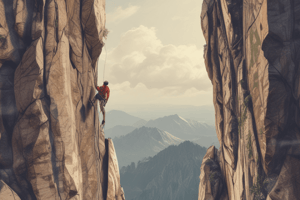Podcast
Questions and Answers
What is the International Olympic Committee-recognized world organization for mountaineering and climbing?
What is the International Olympic Committee-recognized world organization for mountaineering and climbing?
- International Mountaineering and Climbing Federation (IMCF)
- International Climbing and Mountaineering Federation (UIAA) (correct)
- International Mountain Climbing Association (IMCA)
- International Climbing Association (ICA)
What is the term used to describe terrain in which no technical equipment is needed?
What is the term used to describe terrain in which no technical equipment is needed?
- Walk-up (correct)
- Scrambling
- Bouldering
- Free climbing
What is the best treatment for altitude sickness?
What is the best treatment for altitude sickness?
- Take painkillers
- Stay at the same altitude
- Drink more water
- Descend immediately (correct)
What are the two types of hazards that mountaineers face?
What are the two types of hazards that mountaineers face?
What are some examples of objective hazards that mountaineers face?
What are some examples of objective hazards that mountaineers face?
What are some examples of subjective hazards that mountaineers face?
What are some examples of subjective hazards that mountaineers face?
What is the name for the technique used to place anchors into the rock to safely ascend a mountain?
What is the name for the technique used to place anchors into the rock to safely ascend a mountain?
What is the name for the advanced techniques used for extremely slippery or steep snow, ice, and mixed rock and ice terrain?
What is the name for the advanced techniques used for extremely slippery or steep snow, ice, and mixed rock and ice terrain?
What is the term used to describe the style of climbing where mountaineers attach everyone together with a rope and secure themselves by attaching the rope to anchors?
What is the term used to describe the style of climbing where mountaineers attach everyone together with a rope and secure themselves by attaching the rope to anchors?
Flashcards
Mountaineering
Mountaineering
Ascending mountains, including climbing, skiing, and via ferratas.
UIAA
UIAA
The International Olympic Committee-recognized world organization for mountaineering and climbing.
"Walk-up" or "Trek"
"Walk-up" or "Trek"
Terrain where no technical equipment is needed for ascent.
Alpine Rock Climbing
Alpine Rock Climbing
Signup and view all the flashcards
Ice Climbing/Mixed Climbing
Ice Climbing/Mixed Climbing
Signup and view all the flashcards
Rope Team
Rope Team
Signup and view all the flashcards
Anchors (Mountaineering)
Anchors (Mountaineering)
Signup and view all the flashcards
Crevasses
Crevasses
Signup and view all the flashcards
Objective Hazards
Objective Hazards
Signup and view all the flashcards
Study Notes
The sport of mountaineering involves ascending mountains and includes activities such as traditional outdoor climbing, skiing, and traversing via ferratas. Women's participation in mountaineering has grown, but the gender gap is still pronounced in terms of quantitative engagement. Competitive mountaineering has a higher success rate for females than males. Unlike most sports, mountaineering lacks widely applied formal rules, regulations, and governance. The International Climbing and Mountaineering Federation (UIAA) is the International Olympic Committee-recognized world organization for mountaineering and climbing. Mountaineering impacts communities on economic, political, social and cultural levels. Humans have been present in mountains since prehistory, but the highest mountains were rarely visited early on, and were often associated with supernatural or religious concepts. The Age of Enlightenment and the Romantic era marked a change of attitudes towards high mountains. The emergence of the middle-class in the 19th and 20th centuries resulted in mass interest in mountaineering. Mountaineering techniques vary greatly depending on location, season, and the particular route a mountaineer chooses to climb. The term "walk-up" or "trek" is used to describe terrain in which no technical equipment is needed. Alpine rock climbing involves technical skills including the ability to place anchors into the rock to safely ascend a mountain. For extremely vertical rocks, or to overcome certain logistical challenges, climbers may use aid climbing techniques. Compacted snow conditions allow mountaineers to progress on foot, frequently requiring crampons to travel efficiently and safely over snow and ice.Mountaineering Techniques and Hazards
- Mountaineers climb in different styles such as expedition style and alpine style.
- Mountaineers may choose to form a rope team, attach everyone together with a rope, and secure themselves by attaching the rope to anchors.
- Anchors include snow stakes, pickets, flukes, buried equipment or rocks, and carved out bollards.
- Crevasses pose a grave danger to a climber who is not roped in. Members of the rope team may proceed with a crevasse rescue to pull the fallen climber from the crevasse.
- For extremely slippery or steep snow, ice, and mixed rock and ice terrain, climbers must use more advanced techniques, called ice climbing or mixed climbing.
- Shelter is a very important aspect of safety for the climber as weather in the mountains may be very unpredictable.
- Mountaineers use a few different forms of shelter such as alpine shelters, arctic shelters, tents, bivouac sacks, and mountain huts.
- Climbers face two types of hazards, objective (mountain-based) and subjective (human-based).
- Objective hazards relate to the environment, and may include inclement weather conditions, dangerous terrain, duration of exposure, and other environmental conditions.
- Subjective hazards relate to a climber's poor judgement, poor planning, lack of skills, faulty analysis and conclusions, or inadequate conditioning.
- Mountaineers face dangers such as loose or falling rocks, falling ice, snow-avalanches, falls from ice slopes, falls down snow slopes, falls into crevasses, and the dangers from altitude and weather.
- The best treatment for altitude sickness is to descend immediately. Common symptoms of altitude sickness include severe headache, sleep problems, nausea, lack of appetite, lethargy, and body ache.
Studying That Suits You
Use AI to generate personalized quizzes and flashcards to suit your learning preferences.




